Minds On
Warm up
Before you begin, don't forget to do your safety check!
Warm Up
Breathing exercise
We are going to begin with a breathing activity.
Find a comfortable position. Focus your attention on one part of the body at a time.
How does that part of your body feel? If possible, take a deep breath and allow your lungs to expand.
Focus your attention on one part of your body. Allow that part to relax before moving on to the next. As you scan through your body, keep breathing deeply. Once you have completed the scan, take a moment to stretch.

If you wish, you can access this recording entitled “Deep Breathing” to complete your breathing activity.
Deep Breathing
Drama game
Flashback, flashforward
Explore the following image. What might have happened just before the dragon and rider took to the sky? What might happen next?

A person flying a dragon over a field of trees and steams. The person is dressed in armour with horns on their helmet. The dragon has a harness on its muzzle. They both appear to be inside the pages of a book.
Time to create a tableau! Explore this video entitled “What is a Tableau?” to learn about the four different features of a tableau. The four features are stillness, facial expressions, filling the space, and levels.
Begin by creating a tableau of the first scene, second scene, and third scene.
Let’s get started
“The Lion and the Mouse”
Explore the following fable “The Lion and the Mouse” adapted from Aesop’s Fables.
“The Lion and the Mouse”

A Lion lay asleep in the forest, his great head resting on his paws. A timid little Mouse came upon him unexpectedly, and in her fright and haste to get away, ran across the Lion’s nose. Roused from his nap, the Lion laid his huge paw angrily on the tiny creature.
“Spare me!” begged the poor Mouse. “Please let me go and some day I will surely repay you.”
The Lion was much amused to think that a Mouse could ever help him. But he was generous and finally let the Mouse go.
Some days later, while stalking his prey in the forest, the Lion was caught in the toils of a leftover fishing net. Unable to free himself, he filled the forest with his angry roaring. The Mouse knew the voice and quickly found the Lion struggling in the net. Running to one of the great ropes that bound him, she gnawed it until it parted, and soon the Lion was free.
“You laughed when I said I would repay you,” said the Mouse. “Now you see that even a Mouse can help a Lion.”
Pause and Reflect
Pause and reflect
How might someone take the story and transform it into a drama production?
Who are all of the different people who work to bring the story to stage?
Brainstorm and share your thoughts with a partner, if possible.
Action
Get ready, get set…
What is a director?
A director builds a creative vision for a drama production (e.g., play, film, etc.) Their creative vision includes deciding how to share the overall theme and message of the production. A director considers what kind of experience they want to share with the audience.
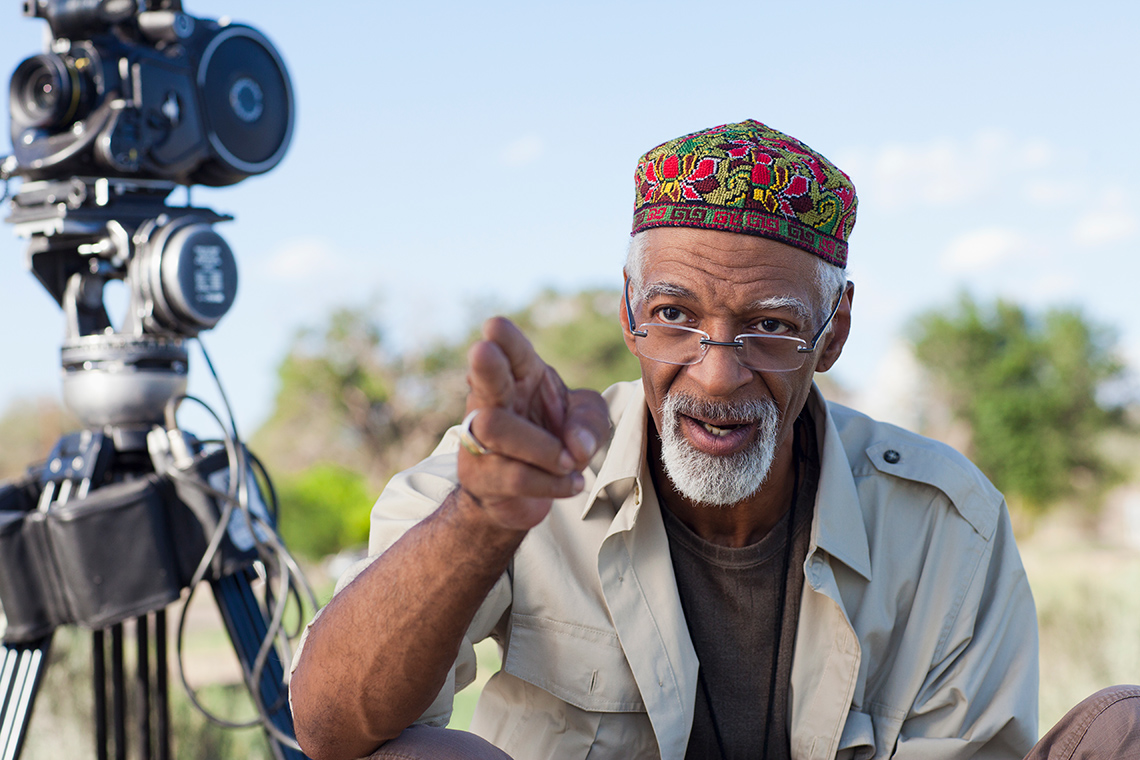
Once they make certain choices, they work together with the actors to help build their characters.They provide suggestions and ideas on how they might use their movements, facial expressions, and/or voice in their performance.
Explore the following videos which demonstrate how an actor can use different tools to act out a character.
Next, a director works together with the crew to bring their creative vision together. This involves working closely with the actors, scenic designers, costume designers, lighting designers, and other people working on the crew. Together, they collaborate to make the production come together.
Press the following tabs to explore how various roles contribute to making a finished production.
The scenic designer begins designing different parts of the set. The set might remain the same throughout a drama production or change from scene to scene. Explore the following set design. How does it make you feel?

Matt Kizer's set for the Kearsarge Arts Theatre production of Disney's Beauty and the Beast.
A stage from the seat of the audience. An actor is on stage and dressed in old clothes. The stage floor looks like dirt and there are cobbled steps leading to a higher, second level of the stage. The stage background is covered in the shadows of leafless tress. It appears to be duck.
The costume designers begin to research and create costume designs for each of the characters in the drama production. Based on the costume design, what can you tell about the actor’s character?
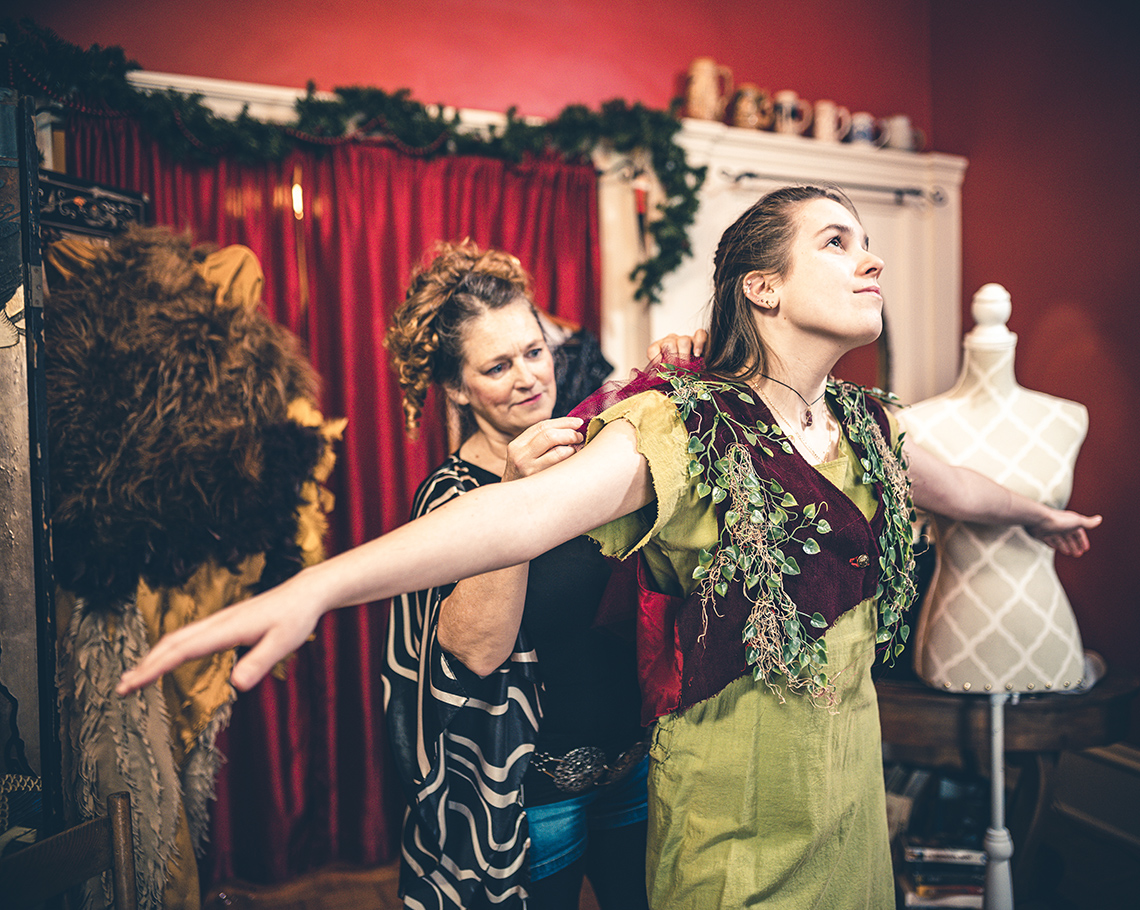
The makeup artists begin to research and decide on specific makeup needed for each character. This might include basic makeup, prosthetics, and/or special effects makeup. How might make-up help an actor get into character?
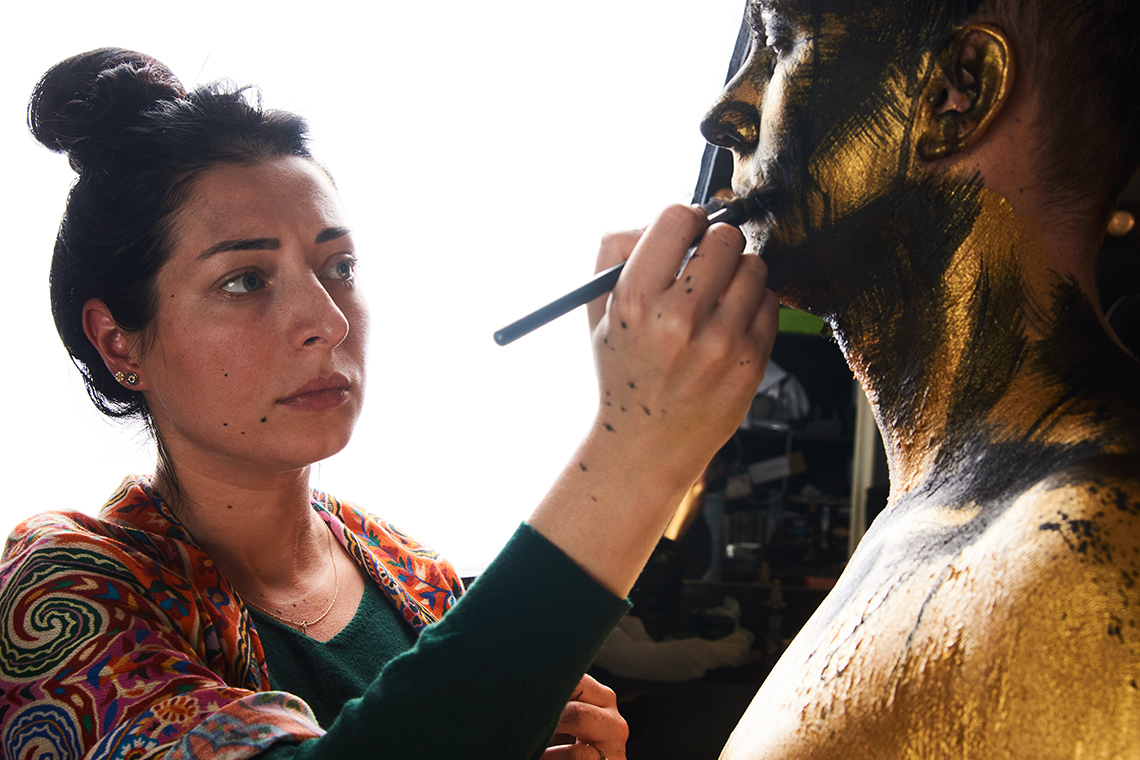
The prop designers begin to create props for characters and to add to the set design. What might the prop designer be creating in the following image?
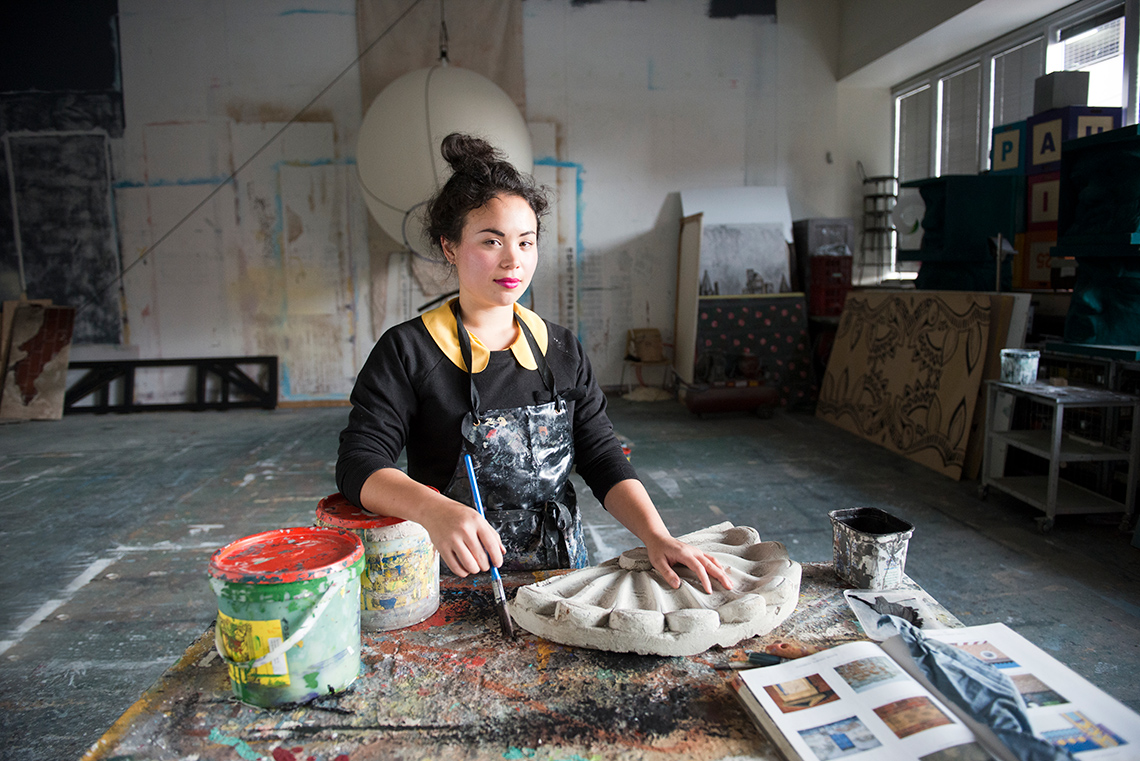
Lighting designers begin to work on determining how lighting can enhance the mood or atmosphere during different scenes in the drama production.
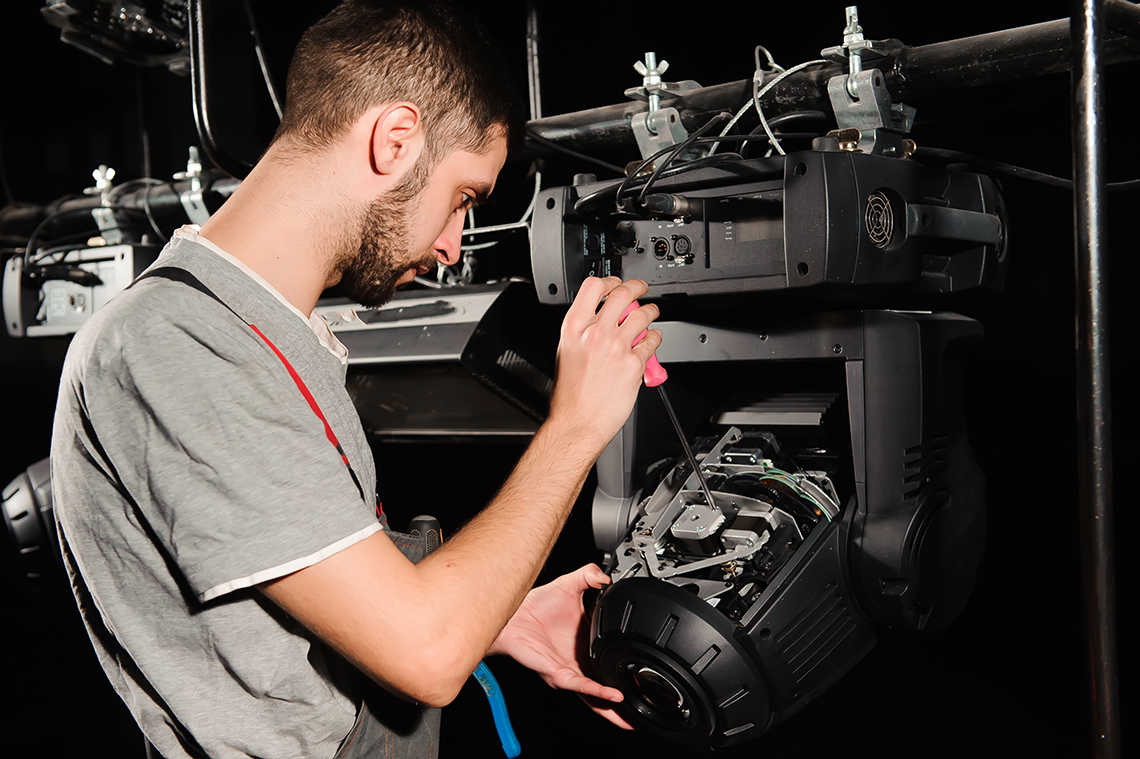

The sound designers begin to brainstorm and create sound clips, musical accompaniments, and items that can be used to create sound effects.
Explore the video to learn more about how sound effects are made.
Access the first sound effect and consider how it could be used in a play or a drama production.
Explore the following sound effect. How might the following sound effect be used in a play or a drama production?
Door Wood
Press ‘Audio’ to access a description of the first sound effect.
A creaking door being opened is creating a suspenseful noise.
Let’s explore the following two sound effects. After you have explored them both, compare the two of them.
Forest Day
Forest Night
Press ‘Audio’ to access descriptions of the sound effects.
Audio 1: There are the sounds of wind rushing through the forest with rustling leaves and a babbling brook in the background.
Audio 2: There are crickets chirping and owls hooting. The night feels more alive with animals than the day.
What sort of mood does each sound effect create? Is it a different mood for each one?
Director’s brainstorm
A director figures out their creative vision even before rehearsals start. They think about the best way to tell a story.
Explore the fable “The Lion and the Mouse” by Aesop. Consider how this story might be adapted to the stage.
“The Lion and the Mouse”

A Lion lay asleep in the forest, his great head resting on his paws. A timid little Mouse came upon him unexpectedly, and in her fright and haste to get away, ran across the Lion’s nose. Roused from his nap, the Lion laid his huge paw angrily on the tiny creature.
“Spare me!” begged the poor Mouse. “Please let me go and some day I will surely repay you.”
The Lion was much amused to think that a Mouse could ever help him. But he was generous and finally let the Mouse go.
Some days later, while stalking his prey in the forest, the Lion was caught in the toils of a leftover fishing net. Unable to free himself, he filled the forest with his angry roaring. The Mouse knew the voice and quickly found the Lion struggling in the net. Running to one of the great ropes that bound him, she gnawed it until it parted, and soon the Lion was free.
“You laughed when I said I would repay you,” said the Mouse. “Now you see that even a Mouse can help a Lion.”
Now that you have explored the story again, reflect on the following questions:
- Would you use a large or small stage?
- Would the set be complex or simple?
- Would the production require elaborate costumes and/or props? Or would the choice of costumes and props be simple so that the actors have to rely on characters only through movement, facial expressions, and voice?
- Would the production require music and/or sound effects?
Record your answers using a method of your choice.
Story to script
Next, access how the playwright transformed the story into a script. Notice how the narration has been changed to stage directions and dialogue.
Explore the following script for the fable “The Lion and the Mouse” from Aesop’s Fables.
|
ACT ONE Scene 1 AT RISE: Lights brighten on interior of a forest. LION is on the ground, sound asleep, his head resting on his paws. MOUSE enters and squeaks. MOUSE (whispering) Oh! Oh no! A lion! I had better be careful. Mouse runs away from Lion but in their haste, runs across Lion’s nose, waking them up. LION (yawning) What? What’s this? Ah ha! I got you! Lion lays his huge paw on the tiny mouse. MOUSE (frightened) Spare me! Please, please let me go. One day I will repay you. Lion laughs loudly. LION You? Repay me? I’m not sure you will ever do that. But we shall see. I will let you go. MOUSE Oh thank you! Thank you! Mouse scurries off. Lion yawns and falls asleep again. ACT ONE Scene 2 AT RISE: Lights brighten on interior of a forest. LION is stalking his prey when they get caught in a net. LION What? No! I can’t escape. What will I do? Lion roars loudly in anger and frustration. Mouse appears on the other side of the stage. MOUSE What is that mighty roaring? It sounds as if it’s LION. Maybe he’s in trouble. Mouse rushes quickly to Lion. MOUSE (seeing Lion in a net) Oh no! You are trapped in the net. Don’t worry, I will save you. LION (moaning) How can you save me? You are too small. I will be stuck here forever. MOUSE Don’t be silly. Just give me a moment. Mouse begins to gnaw at the ropes. She bites at the ropes until Lion is free and able to escape from the net. LION You did it! I’m free. Lion roars in relief. MOUSE You laughed when I said I would repay you. Now you see that even a Mouse can help a Lion. Remember, A kindness is never wasted. |
Press the ‘Activity’ button to access “The Lion and the Mouse”.
A director’s perspective
If you were the director of “The Lion and the Mouse” by Aesop, what would your creative vision for the play be?
Consider the following when designing your creative vision:
Elements to consider
Then consider, what notes would you provide to the actors on how to act out each character?
Complete the Creative Vision Planner in your notebook or using the following fillable and printable document. If you would like, you can use speech-to-text or audio recording tools to record your thoughts. Share with a partner, if possible. Consider adding your work to your drama portfolio.
| Creative Vision: |
| The Lion: |
| The Mouse: |
Press the ‘Activity’ button to access Creative Vision Planner.
If you wish, you may explore an example director’s vision for a production of the “The Lion and the Mouse.”
Press ‘Example’ to access another director’s creative vision.
Begin by exploring this director’s creative vision.
Access this recording entitled “Director’s Creative Vision” to explore what they have envisioned for the production.
Director’s Creative Vision
Now, explore the director’s instructions for each of the characters.
Check out this recording entitled “The Lion” to learn about how the director wants the role of the lion to be played.
The Lion
Explore this recording entitled “The Mouse” to learn about how the director wants the role of the mouse to be played.
The Mouse
Go!
Imagine you are the director of a production of Aesop’s “The Hare & the Tortoise.” Explore the story and then examine the script.

“The Hare & the Tortoise”
A Hare was making comments about the Tortoise and how the Tortoise moves slower than then they do. The Tortoise challenged the Hare to a race. The Hare was much amused at the idea of running a race with the Tortoise, but for the fun of the thing he agreed.
The Fox, who had agreed to act as judge, marked the distance and started the race.
The Hare was soon far out of sight, and to make the Tortoise feel very deeply how ridiculous it was for him to try a race with a Hare, he lay down beside the course to take a nap until the Tortoise should catch up.
The Tortoise meanwhile kept going slowly but steadily, and, after a time, passed the place where the Hare was sleeping. But the Hare slept on very peacefully; and when at last he did wake up, the Tortoise was near the goal. The Hare now ran his swiftest, but he could not overtake the Tortoise in time.
Lesson: The race is not always to the swift.
Director’s brainstorm
Now that you have explored the story again, reflect on the following questions:
- Would you use a large or small stage?
- Would the set be complex or simple?
- Would the production require elaborate costumes and/or props? Or would the choice of costumes and props be simple so that the actors have to relay their characters only through movement, facial expressions and voice?
- Would the production require music and/or sound effects?
Record your answers using a method of your choice.
Story to script
Use the following script of the story to create notes. You may underline, highlight, and write notes in the margins or end of the page.
Complete the Script Note Taker in your notebook or using the following fillable and printable document. If you would like, you can use speech-to-text or audio recording tools to record your thoughts.
|
ACT ONE Scene 1 AT RISE: Light brightens on a garden on a warm summer day. TORTOISE and HARE are talking. HARE (mockingly) You are so slow! Do you ever get anywhere? I mean, c’mon. I am way faster than you are. TORTOISE Yes, I get places. And I get there sooner than you think. I’ll run you a race and prove it. Hare laughs heartily. HARE You? You want to run a race with me? Fine. FOX enters. HARE Fox! Will you be the judge of our race? I am racing this silly tortoise. FOX I will be the judge. Here is the starting point. Fox lays down some rocks as a starting point. FOX And the end point is the hollow tree by the pond. Get ready, get set, go! Hare and Tortoise begin to race. Hare is soon far out of sight. HARE That silly tortoise. I want to prove to him how ridiculous it is to try to race me. I’m going to take a quick nap until Tortoise wakes up. Hare lays down and soon falls fast asleep. The Tortoise keeps racing slowly but steadily finally reaching the place where the Hare was sleeping. TORTOISE That silly hare. Having a nap when we are supposed to be racing. I can see the hollow tree up ahead. I think I can make it. HARE (waking up with a start) What? What’s going on? Hare noticed up ahead that Tortoise was almost at the tree. HARE Oh no! I can still beat that tortoise though. Hare runs fast but doesn’t catch up to tortoise. FOX Tortoise wins! TORTOISE See? I told you I could race you. HARE (sheepishly) I guess you were right. FOX You have learned, silly hare, that the swift does not always win the race. |
Press the ‘Activity’ button to access Script Note Taker.
Consolidation
Putting it all together

Using the notes you created in the Action section, complete the following template with your creative vision for your production of “The Hare & the Tortoise.”
Complete the Creative Vision Template in your notebook or using the following fillable and printable document. If you would like, you can use speech-to-text or audio recording tools to record your thoughts. Consider adding your work to your drama portfolio.
| My creative vision |
| My notes for the Tortoise |
| My notes for the Hare |
Press the ‘Activity’ button to access Creative Vision Template.
Portfolio
Next steps
Reflect on the following questions and record your thoughts using a method of your choice. Consider adding your ideas to your drama portfolio.
- As the director, who would you meet with now that you have decided on your creative vision?
- How might your vision change after speaking to members of the cast (actors) and crew?
Pause and Reflect
Pause and reflect
- Who does the director collaborate with on a drama production?
- Why is collaboration or working together with others to brainstorm ideas important?
Reflection
As you read through these descriptions, which sentence best describes how you are feeling about your understanding of this learning activity? Press the button that is beside this sentence.
I feel…
Now, record your ideas using a voice recorder, speech-to-text, or writing tool.